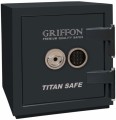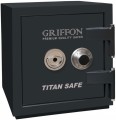Burglary resistance class
A parameter that characterizes the degree of resistance of the safe to burglary - that is, direct damage to the door or wall in order to gain access to the contents.
Safes manufactured in different countries have different certifications for burglary resistance. So, in accordance with the Ukrainian standard DSTU EN 1143-1:2019, there are 13 classes of burglary resistance of safes. The same number of gradations are available in the ECB-S marking, which is assigned to safes by the European Security Systems Association (ESSA). The classification covers not only resistance to damage, but also the tear resistance of an anchored safe, and bracing is required to classify safes weighing less than a one ton (see below). Pull-off resistance is simply determined by the force required to remove it from the mount; this force is indicated in newtons, 10 N corresponds approximately to a force of 1 kg. To assess the resistance to damage there are so-called resistance units (Ru) - breaking time multiplied by the coefficient of resistance of the tool used. For each type of tool, the coefficients are different - for example, from 1 to 5 for a chisel, 5 for an electric drill, etc. For example, if a control sample of a safe of a certain model was cracked by a drill in 4 minutes, then its resistance to cracking is 20 Ru. Note that the check is carried out in two versions - for full and partial access to the contents of the safe; when assigning a class, both results are taken into accou
...nt, they are often written as "partial/full resistance", for example 120/180.
Now there are safes on the market with the following burglary resistance classes: H0 class, Class 0, Class I, Class II< /a>, Class III. Safes with a higher burglar resistance class (Class IV, V class, Class VI, Class VII, Class VIII) are much less common.
Detailed data for each class can be found directly in the regulatory documentation. For example, here are the first three classes:
— H0 class (“below zero”). Minimum burglary resistance class to be certified. Requires a resistance of at least 15 Ru for both access options, and a pull force of at least 50 kN.
- 0 class. Safes with a resistance of at least 30/30 Ru and a pull force of 50 kN or more.
- I class. Models with a resistance of at least 50/30 Ru and a breakout force of 50 kN. The minimum class for safes classified in our catalog as burglar-resistant (see "Product Type").
There are also more burglary-resistant models on the market - up to class VIII.
The burglary resistance class is confirmed by a certificate issued by state bodies for technical regulation and standardization. The validity period of the certificate is limited, and usually it is much less than the time during which this or that model is produced. Therefore, safes are regularly re-certified. For a number of reasons, new results may differ from previous results and correspond to a different resistance class than that recorded in the outdated certificate. Therefore, over time, the class of the same model may change even if the quality of the safes themselves remains unchanged.Types of locks
The number and types of locks provided in the design of the safe for locking the main compartment.
—
Key. Locks that can be opened/closed in the classical way with a key. The key is convenient in use that you do not have to remember the digital combination. In addition, such a lock is extremely easy to use, and also makes it easier to manage access to the safe: if necessary, the key can be given to another person, and taking it away can deprive him of access without having to reconfigure the lock. On the other hand, the key can be lost or stolen, with corresponding unpleasant consequences; and the danger of opening with a master key should not be ruled out (although in most cases it is rather difficult).
—
Mechanical combination. A mechanical combination lock that can be opened with a numerical code. The code is usually entered by turning a special drum. This type compares favourably with the key one due, in fact, to the absence of a key — to open it, it is enough to know a combination of numbers. On the other hand, the combination requires reliable memory, and the code fixed “just in case” on paper or other media can be not only lost or stolen, but also read without the knowledge of the owner. In addition, the procedure for working with the lock itself is quite complicated and can cause difficulties if you are not used to it. It is also worth considering that some models of such locks
...do not provide the code changing; this point should be clarified when buying.
— Electronic. A lock controlled by electronic circuits and opened with a numerical cipher. Such locks are similar to the mechanical devices described above — but instead of a wheel, they are equipped with conventional numeric keypads, which greatly simplifies the operation. Also, the use of electronics instead of mechanics provides a number of other advantages: the cipher can be easily changed, its length can be longer, the built-in display allows you to control the correctness of the input, etc. Of the significant cons of such locks, it is worth mentioning perhaps the need for power supply, but for a number of reasons this moment does not play a decisive role.
Note that some safes are equipped with locks of different types — usually key and electronic. This makes storage more versatile. Also, individual compartments may differ by type of locks (see "Number of compartments").
— Biometric (fingerprint). A kind of electronic locks, that use the user's fingerprint instead of a key. This option is extremely convenient due to the fact that the user does not need to carry a key with him (at the risk of losing it or being forced to intruder) or remember a numerical combination — he can open the lock by simply placing his finger on the sensor, while the opening of safe will not take a place with the fingerprints of an intruder. Most biometric locks are capable of storing multiple fingerprints in memory, which allows access to multiple people at once and provides additional security in case of failure.Lock model
This paragraph indicates the manufacturer of the safe lock.
Weight
The total weight of the empty safe. Unlike many other products, for safes, heavy weight is usually more of an advantage than a disadvantage: the heavier the safe, the more difficult it is to steal it entirely for later opening in a safe place. The only exceptions are portable and automotive models (see "Product Type") — in their case, theft prevention is ensured primarily by fastening, and in the first case, the product, by definition, must be suitable for carrying in hands.

